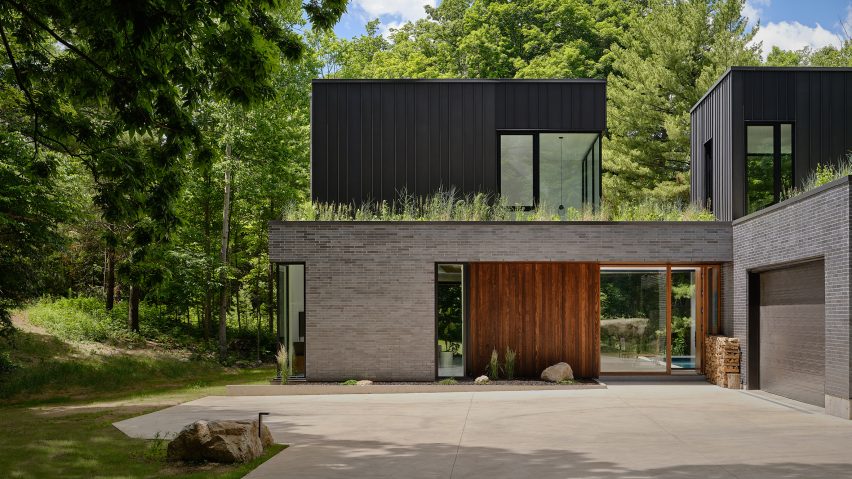Drew Mandel Architects designed a house in Milton, Canada with exteriors of metal, brick and wood that is centred around a walnut staircase.
Situated within a forest on the Niagara Escarpment, the 6,780-square-foot (630-square metre) house was completed in 2022.
Drew Mandel Architects – a Toronto-based studio – designed the home to embrace and pay tribute to its natural surroundings.
The project's name – Oneida Ridge – references a legend about the Oneida People of the Iroquois Confederacy who were under attack, fled into the trees and transformed into standing boulders.
The six-acre property is protected by Conservation Halton, and the design process involved an extensive environmental impact assessment to investigate migration patterns, habitats, native species and local plants and document endangered species to assure the preservation of existing woodlands.
Located in a natural clearing, the structure is arranged in a pinwheel that orients each space to the surrounding landscape.
The house is divided into two wings linked by a glazed entry.
The north wing contains a garage and workshop spaces topped with a recreation room, while the south wing is composed of living spaces topped with bedrooms.
Floor-to-ceiling windows maximise natural light and open the ground floor to dramatic rock formations and the upper level to the surrounding tree canopy.
Excavated boulders are scattered throughout the site creating a rock garden at the entrance and seating on the rear terrace. The house is capped with a roof garden with native plants.
"Natural materials are used on the interiors and around the site to celebrate the essence of the place," the studio said.
The forms are clad with manganese ironspot brick and standing seam zinc panels with ash wood soffits soften the whole.
The interior features exposed concrete – wrapped around the corner of the fireplace – stone surfaces and walnut wood floors, ceilings and millwork.
"The walnut staircase is the sculptural centrepiece of the residence, connecting the two wings and orienting the visitor with views in all directions," said studio founding principal Drew Mandel.
"Pill-shaped walnut piers act as a required guard and provide a screen backdrop to the main living space," he continued.
"The screen transitions to a solid wood wall and built-in planter at the second-floor bridge, atop the double-height space."
The staircase has a cantilevered landing and conceals mechanical ducting, while two-sided glazing affords views to the entry court, pool, specimen tree, green roofs and landscape beyond.
"For secluded property that is inhabited year-round, considerable independent site services are vital and contribute to the sustainability of the residence," the studio said, referencing the design's geothermal heating, photovoltaic roof panels, septic bed and private well.
Contrasting materials are a signature of Drew Mandel Architects' designs, as evident in the studio's brick and concrete country home and stone and zinc Toronto house.
The photography is by Doublespace Photography.
Project credits:
Architect & Interiors: Drew Mandel Architects (Project team: Drew Mandel, Jowenne Poon)
Construction: Marcus Design Build
Structural: Blackwell Engineering
Millwork: Wellington Millwork Inc.
Roofing: Trio Roofing Systems Inc.
Furniture: Klaus

